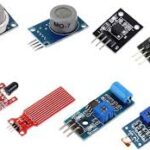Introduction
Sensors are the backbone of modern technology, enabling automation, real-time data collection, and enhanced system efficiency across various industries. From smartphones and smart homes to industrial automation and healthcare monitoring, sensors play a crucial role in gathering and transmitting data.
The global sensors market is witnessing rapid growth, driven by advancements in IoT (Internet of Things), AI (Artificial Intelligence), and Industry 4.0. The rising adoption of smart devices, autonomous vehicles, and wearable health monitors is further accelerating the demand for innovative sensor solutions.
This article explores the types of sensors, market trends, emerging technologies, and future prospects of the sensor industry.
Understanding Sensors and Their Role
What Are Sensors?
A sensor is a device that detects physical, chemical, or environmental changes and converts them into measurable signals. These signals are then processed for analysis, control, or decision-making in various applications.
How Do Sensors Work?
Sensors capture external stimuli such as temperature, pressure, motion, or light.
They convert this data into electrical signals.
The signals are transmitted to processing units (microcontrollers, AI models, or cloud platforms).
Based on the analysis, automated actions or alerts are triggered.
Applications of Sensors Across Industries
Consumer Electronics: Used in smartphones, smartwatches, and home automation.
Automotive Industry: Enable features like ADAS (Advanced Driver Assistance Systems), LiDAR, and parking sensors.
Healthcare: Power medical devices such as heart rate monitors, glucose sensors, and wearables.
Industrial Automation: Help in robotics, smart manufacturing, and predictive maintenance.
Key Market Drivers and Trends
Rise of IoT and Smart Devices
With billions of connected devices, IoT applications rely heavily on sensors for real-time monitoring and automation. Smart homes, smart cities, and industrial IoT (IIoT) are key contributors to this growth.
Growing Demand for Automation and AI Integration
AI-powered sensors enhance automation, self-learning, and real-time decision-making.
AI and machine learning enable sensors to predict failures in industrial settings, improving efficiency.
Increasing Use of Sensors in Healthcare and Automotive Sectors
Healthcare demand for wearable devices and remote patient monitoring has surged.
The automotive industry is integrating more sensors in electric vehicles (EVs) and self-driving cars.
4. Types of Sensors in the Market
Sensor Type Function Common Applications
Temperature Sensors Measure heat levels HVAC, automotive, medical devices
Pressure Sensors Detect changes in pressure Industrial machinery, weather forecasting
Motion & Proximity Sensors Detect movement or distance of objects Security systems, smartphones, automation
Optical Sensors Measure light intensity and wavelength Cameras, medical imaging, barcode scanners
Gas & Chemical Sensors Detect gas leaks, air quality, and hazardous chemicals Environmental monitoring, safety systems
Industry-Wise Applications of Sensors
Healthcare: Wearable and Diagnostic Sensors
Smartwatches and fitness trackers use heart rate and SpO2 sensors.
Non-invasive glucose monitoring sensors for diabetic patients.
Biosensors help in early disease detection and diagnostics.
Automotive: ADAS, LiDAR, and Vehicle Monitoring
LiDAR and radar sensors for autonomous vehicle navigation.
Tire pressure monitoring sensors for safety.
Temperature and battery monitoring sensors in electric vehicles (EVs).
Industrial Automation: Robotics and Smart Manufacturing
Sensors enable predictive maintenance in industrial equipment.
Smart factories use sensors for real-time machine performance monitoring.
Robots equipped with sensors improve precision and reduce human intervention.
Consumer Electronics: Smartphones, Smartwatches, and Home Automation
Gyroscopes, accelerometers, and ambient light sensors in smartphones.
Voice assistants use acoustic sensors for speech recognition.
Smart homes rely on sensors for security, climate control, and automation.
6. Emerging Technologies in the Sensors Market
AI-Powered Smart Sensors
AI algorithms analyze sensor data in real time, improving efficiency.
AI-enabled sensors in traffic management, predictive healthcare, and security.
MEMS (Microelectromechanical Systems) Technology
Miniaturized sensors with lower power consumption and higher accuracy.
Used in wearable tech, medical devices, and drones.
Nanotechnology-Based Sensors
Ultra-sensitive sensors for air quality monitoring, medical diagnostics, and food safety.
Nanotechnology enables faster and more accurate sensing.
Wireless and Energy-Efficient Sensors
IoT-based wireless sensor networks (WSNs) for remote monitoring.
Energy harvesting sensors reduce reliance on batteries.
Challenges in the Sensors Market
High Development and Production Costs
Advanced sensors require expensive materials and precision engineering.
High R&D costs make affordability a challenge.
Data Privacy and Security Concerns
IoT and connected sensors are vulnerable to cyberattacks.
Need for secure data transmission protocols and encryption.
Standardization and Interoperability Issues
Lack of universal communication standards among sensor manufacturers.
Integration challenges across different industries and applications.
Regional Insights: Sensors Market Across the Globe
North America: Leading Innovations and Market Share
Strong presence of tech giants and semiconductor companies.
High adoption of IoT and AI-based sensors.
Europe: Growth in Automotive and Industrial Applications
Germany and France lead in automotive sensor integration.
Expansion in smart manufacturing and Industry 4.0.
Asia-Pacific: Rapid Expansion in Consumer Electronics and IoT Adoption
China, Japan, and South Korea dominate sensor production.
High demand for smartphones, wearables, and smart home devices.
Latin America & Middle East: Emerging Opportunities in Industrial Automation
Investments in smart infrastructure and security systems.
Expansion in oil & gas monitoring sensors.
Key Players in the Sensors Industry
Top Companies Leading the Market
Bosch Sensortec
Texas Instruments
STMicroelectronics
Honeywell International
TE Connectivity
Market Competition and Investment Trends
Heavy investments in MEMS and AI-powered sensors.
Increased mergers and acquisitions for technology expansion.
10. Future Trends and Market Outlook
Growth of AI-Integrated Sensors
AI will drive autonomous decision-making in sensor applications.
Expansion of IoT-Driven Applications
IoT sensors will expand into smart agriculture, logistics, and security.
Predictions for the Next Decade
The sensors market will surpass $300 billion by 2030.
Nanotechnology and AI-driven sensors will dominate innovation.
Conclusion
The sensors market is experiencing exponential growth, fueled by advancements in AI, IoT, and Industry 4.0. Sensors are now integral to almost every industry, from automotive and healthcare to consumer electronics and industrial automation.
As new technologies like AI-powered sensors, MEMS, and nanotechnology emerge, the future of sensors will be more precise, energy-efficient, and intelligent. Businesses that invest in smart, connected, and secure sensor solutions will lead the next wave of digital transformation.
Get more Detail: https://www.databridgemarketresearch.com/reports/global-sensors-market

